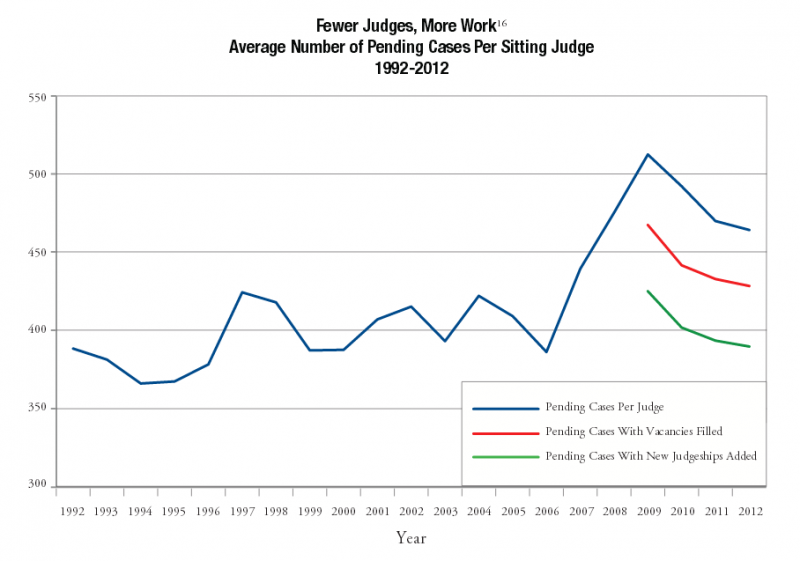Unusually high judicial vacancy levels coupled with unprecedented workloads are burdening federal district courts like never before. Judicial vacancies have remained uniquely high throughout Barack Obama’s presidency, with annual vacancies averaging significantly higher than those experienced during George W. Bush’s presidency. As seats remain unfilled, millions of Americans who rely on district courts are being denied the justice they deserve. The President and the Senate must find a way to fill these crucial seats.
Introduction
Recent public attention on federal judicial vacancies has largely focused on the appellate courts. Yet, since 2009, the slow pace of nominating and confirming judges has also precipitated a crisis in the district courts — the trial level courts that resolve the vast majority of federal cases. As of July 1, 2013, there were 65 vacancies in the district courts out of a total of 677 judgeships, creating a vacancy rate of almost 10 percent. Only 23 nominees are currently pending before the Senate, while 18 district court judges have been confirmed since the start of 2013. The Administrative Office of the United States Courts anticipates that four additional vacancies will open by July 15, 2013, followed by seven more vacancies by January 2014.
The high number of vacant judgeships limits the capacity of district courts to dispense justice and affects the millions of Americans who rely on district courts to resolve lawsuits and protect their rights. District courts are the workhorses of the federal judicial system, resolving legal disputes, conducting civil and criminal trials, and overseeing cases from filing to termination. These courts touch the lives of everyone from the small business owner in a contract dispute, to the family targeted by consumer fraud, to the artist protecting her copyright from infringement. When district courts are not functioning efficiently, it reverberates throughout our entire judicial system.
This analysis examines data on district court vacancies and judicial workloads since 1992. Its findings suggest that judicial vacancy levels are sufficiently high that it is affecting the functioning of our courts.
- Breaking with historical patterns, district court vacancies have remained high throughout Barack Obama’s presidency. District courts typically see brief peaks in vacancies after a presidential election, followed by a sharp decline in subsequent years. Yet, during the Obama administration, after district court vacancies spiked in 2009 they never returned to their previous level and, in fact, have grown further. For the first time since 1992, the average number of district court vacancies has been greater than 60 for five straight years, from 2009–2013.
- Together, high vacancy levels and heavy caseloads are leaving sitting judges with unprecedented workloads. Counting both full-time active judges and part-time senior judges, the number of pending cases per sitting judge reached an all-time high in 2009 and was higher in 2012 than at any point from 1992–2007.
- Vacancies are hurting districts with the greatest needs. Judicial emergencies, a measure by the Administrative Office of the United States Courts of vacancies in districts with the most acute need for judges, have been higher in 2010–2012 than at any other point since 2002 (the last year for which comparable data is available).
These findings demonstrate the urgent need for the President and Senate to act to fill district court vacancies. Indeed, our findings suggest that to fully address the increasing district court workload, more judgeships are required — further highlighting the importance of filling vacant seats now.




